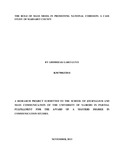| dc.description.abstract | Conflict is a common occurrence among the communities residing in Marsabit county. These
frequent conflicts have resulted in mistrust, suspicion and outright animosity between the local
communities in the area. This study sought to establish the role of mass media in promoting
community cohesion in the area in specific analyzing ways in which the media in de-escalation
of conflicts, factors that hindered effective media coverage of the area, investigation of the role
of media in escalation of the local conflicts and also exploration of the ways in which media
contributed to conflict resolutions. The study established the critical role the media played in deescalation
of conflicts in the area as majority of respondents agreed that the media indeed deescalated
conflicts while the least number of those polled tended to strongly disagree with the
sentiment. Whereas the majority of the respondents cited accurate and objective reporting as the
main way through which the media de-escalated conflicts, a significant number identified
exposing the root cause of the problem as another way by which the media de-escalated
conflicts. Also sensitive reportage as well as avoiding the identity of actors were cited as other
possible ways by which the media could de-escalates conflicts. A majority of 71.4% of the
respondents felt that the media were not giving adequate coverage of issues in the county. This
reinforced the commonly held perception by the locals against the media. On the specific factors
that might have hindered media coverage in the area, majority of the participants identified
distance from the media organization as their main problem while others cited illiteracy among
the local population, and the policy of the individual media houses. Further, 3.2% of the
participants identified socio-cultural factors, while the remaining 10% cited more than any two
of the factors identified above. On the role of media in escalation of local conflicts, 56% of the
respondents were in agreement and identified the possible means as irrational and sensational
reporting (54), insensitive reporting (52), identifying actors at (38) and glorifying violence(33),
while 12 respondents cited all of them. On the role of media in conflict resolutions, an
overwhelming majority that is 98.9% were in agreement, while 1.1% seemed to disagree.
Similarly, on media and county cohesion 181 of those polled were in agreement with 7
disagreeing, while 2 appearing not to know. Therefore, from this study one can deduce that the
media played vital role in promotion of a cohesive and peaceful community in Marsabit county. | en |

